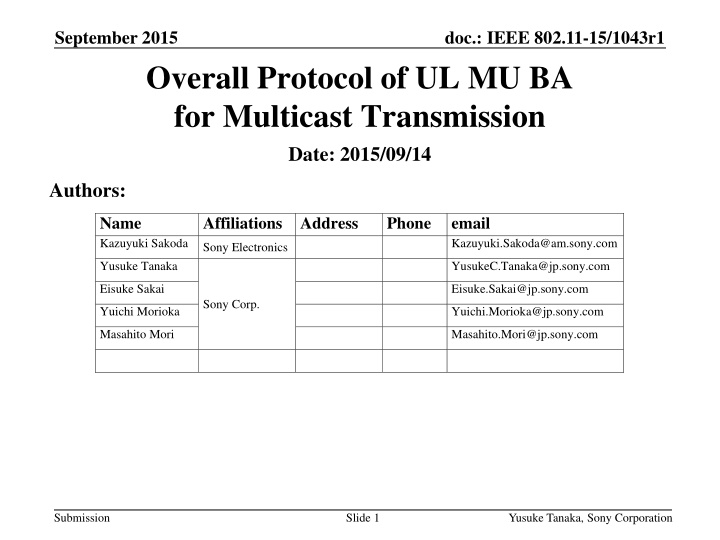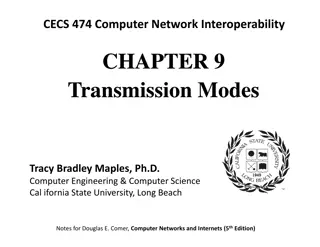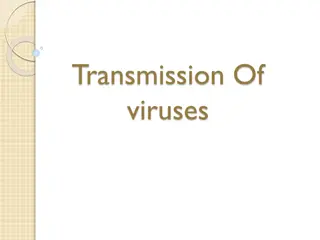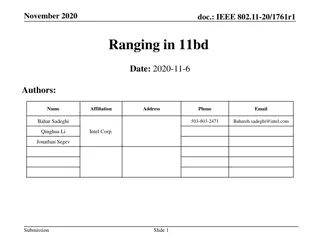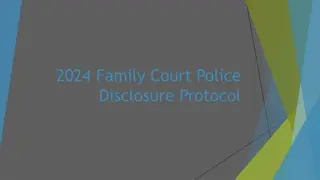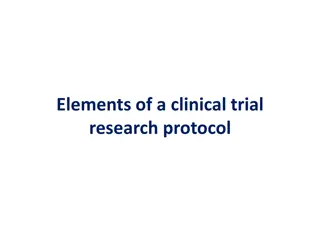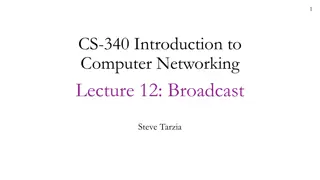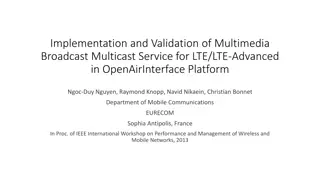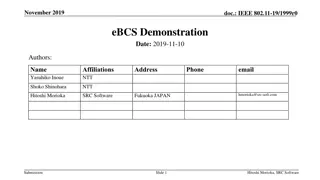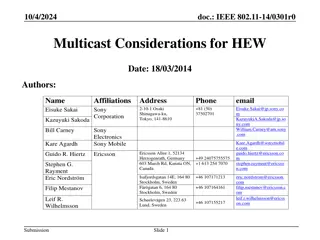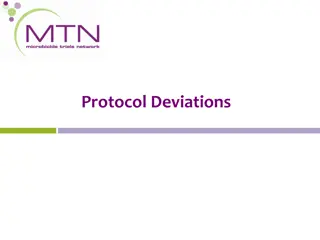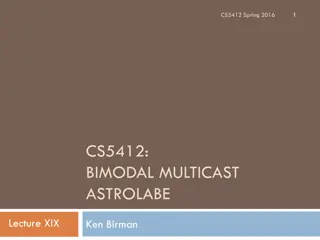Overall Protocol of UL MU BA for Multicast Transmission
This document provides detailed insights into the overall protocol of UL MU BA for multicast transmissions within the framework of IEEE 802.11-15/1043r1. It covers agenda details, background information, protocol overview, simulation results, BAR design for MU BA, and conclusions based on a straw poll. The content outlines the purpose, recap of previous work, and responses to queries, including the application of multiplexing for efficient multicast PPDU transmission.
Download Presentation

Please find below an Image/Link to download the presentation.
The content on the website is provided AS IS for your information and personal use only. It may not be sold, licensed, or shared on other websites without obtaining consent from the author.If you encounter any issues during the download, it is possible that the publisher has removed the file from their server.
You are allowed to download the files provided on this website for personal or commercial use, subject to the condition that they are used lawfully. All files are the property of their respective owners.
The content on the website is provided AS IS for your information and personal use only. It may not be sold, licensed, or shared on other websites without obtaining consent from the author.
E N D
Presentation Transcript
September 2015 doc.: IEEE 802.11-15/1043r1 Overall Protocol of UL MU BA for Multicast Transmission Date: 2015/09/14 Authors: Name Kazuyuki Sakoda Affiliations Address Sony Electronics Phone email Kazuyuki.Sakoda@am.sony.com Yusuke Tanaka YusukeC.Tanaka@jp.sony.com Eisuke Sakai Eisuke.Sakai@jp.sony.com Sony Corp. Yuichi Morioka Yuichi.Morioka@jp.sony.com Masahito Mori Masahito.Mori@jp.sony.com Submission Slide 1 Yusuke Tanaka, Sony Corporation
September 2015 doc.: IEEE 802.11-15/1043r1 Agenda Background & recap Details of overall protocol Protocol overview of UL MU BA for Multicast Summary of 802.11aa BAR for MU BA Simulation results Example of BAR design for UL MU BA Conclusion Straw poll Submission Slide 2 Yusuke Tanaka, Sony Corporation
September 2015 doc.: IEEE 802.11-15/1043r1 Background The TGax Spec Framework Document (SFD)[1] includes mention of BA/ACK multiplexing, as follows; The amendment shall include a mechanism to multiplex BA/ACK responses to DL MU transmission. [MU Motion #4, March 2015] The TGax SFD also includes a definition, as follows; MU features include UL and DL OFDMA and UL and DL MU-MIMO. Data Transmission Phase Response Phase DL MU PPDU AP AP BA/ACK STA x STA x BA/ACK STA y STA y BA/ACK STA z STA z DLMU(OFDMA/MU-MIMO) PPDU UL multiplexed BA/ACK Submission Slide 3 Yusuke Tanaka, Sony Corporation
September 2015 doc.: IEEE 802.11-15/1043r1 Recap of previous work The contribution[2] showed Multiplexing of acknowledgements can be applied for Multicast PPDU to reduce overheads of BA/ACKs from multiple multicast receivers. UL multiplexed BA/ACK Data Transmission Phase Response Phase DL MC PPDU AP AP AP BA/ACK BA/ACK STA x STA x STA x BA/ACK BA/ACK STA y STA y STA y Multiplexing of acknowledgements can reduce the overhead Overhead BA/ACK BA/ACK STA z STA z STA z DL MC(Multicast) PPDU It included a straw poll for a general proposal of multiplexing of acknowledgements as follows, and it received no objection. Do you agree that multiplexing of acknowledgements can work effectively for Multicast PPDU in a similar manner as DL-MU(OFDMA/MU-MIMO) PPDU? (Results = Yes:35 /No:0 /Abstain:28) Submission Slide 4 Yusuke Tanaka, Sony Corporation
September 2015 doc.: IEEE 802.11-15/1043r1 Purpose of this contribution We received some questions about the previous contribution, therefore this contribution shows some answers to them. In addition, this contribution includes simulation results to show effect of UL MU BA for Multicast. Summary of questions and answers 1. About protocol overview of UL MU BA for Multicast This contribution shows details of overall protocol 2. About requirement of update from 802.11aa The protocol is generally based on 802.11aa GCR BAR design only need to be adjust for UL MU BA 3. About determination of BAR destinations Determination based on throughput by using MD report is one of solution. Details are in another[6] and previous contributions[7][8]. Submission Slide 5 Yusuke Tanaka, Sony Corporation
September 2015 doc.: IEEE 802.11-15/1043r1 Agenda Background & recap Details of overall protocol Protocol overview of MU BA for Multicast Summary of 802.11aa BAR design for MU BA Simulation results Example of BAR design for UL MU BA Conclusion Straw poll Submission Slide 6 Yusuke Tanaka, Sony Corporation
September 2015 doc.: IEEE 802.11-15/1043r1 Protocol overview of UL MU BA for Multicast BAR-BA frame exchange is based on 802.11aa Groupcast with Retries Multiplexing of UL BA (e.g. 4 user multiplexing in this picture) Trigger Frame including BAR for multiple devices. Conventional AIFS+BO AIFS+BO AIFS+BO Multicast PPDU BAR BAR BAR AP SIFS BA STA 1 BA STA 2 BA STA 3 STA 4 Proposed Multicast PPDU Trigger Frame including BAR AIFS+BO AP TBD BA STA 1 BA STA 2 BA STA 3 BA STA 4 Submission Slide 7 Yusuke Tanaka, Sony Corporation
Sept. 2015 doc.: IEEE 802.11-15/1043r1 Summary of 802.11aa features The picture below summaries 802.11aa features [3]. Required features to enhance 802.11ax Multicast are in red. 802.11aa features Groupcast with Retries (GCR) GCR Group membership procedures GCR setup procedures GCR frame exchange procedures Concealment of GCR transmissions GCR unsolicited retry 1. Group address transmission service 2. Stream classification service Groupcast with Retries (GCR) Advanced GCR 3. Intra-access category prioritization GCR for Mesh 4. Management of overlapping networks Advanced GCR GCR Block Ack GCR-SP AP Peer Key 5. Support for the IEEE 802.1Q Stream Reservation Protocol Qload Report HCCA TXOP Update Count element Required features to enhance 802.11ax Multicast Mandatory Optional Submission Slide 8 Yusuke Tanaka, Sony Corporation
Sept. 2015 doc.: IEEE 802.11-15/1043r1 Required 11aa features to enhance 11ax Multicast Based on 802.11aa GCR Procedures, AP can collect capabilities, Group Address information and setting of GCR from STAs. Groupcast with Retries (GCR) GCR Group membership procedures GCR setup procedures GCR frame exchange procedures Concealment of GCR transmissions GCR unsolicited retry This procedure defines how an AP collects STAs capabilities. (Robust AV Streaming etc.) Authentication & Association Procedure This procedure defines how an AP collects Group Address information the STAs receive. GCR Group Membership Procedures This procedure defines initiation/termination of GCR and how STAs request Retransmission Policy Advanced GCR GCR Block Ack GCR-SP GCR Setup Procedures This procedure defines details of Retransmission Policy operation and how an AP or STAs change GCR service. Required features to enhance 802.11ax Multicast GCR Frame Exchange Procedures 11aa Mandatory GCR concealment address is defined for legacy protection. Concealment of GCR Transmissions 11aa Optional BlockAckReq and BlockAck exchange, and Management of Bitmapare defined. GCR Block Ack Submission Slide 9 Yusuke Tanaka, Sony Corporation
Sept. 2015 doc.: IEEE 802.11-15/1043r1 Summary of 802.11aa GCR Block Ack BlockAckReq(BAR) and BlockAck(BA) frame exchanges AP transmits A-MSDUs to the GCR group address before sending a BAR. Upon reception of the BA, the AP sends a BAR to another, and this process is repeated. STA transmit a BAat a delay of SIFS after the BAR when the STA receives a BAR. After completing the BAR and BA frame exchanges, the AP determines which A- MSDUs need to be retransmitted from the information provided in the BA bitmap. To realize BAR and UL MU BA frame exchange, BAR need to be adapted to it Groupcast with Retries (GCR) GCR Group membership procedures GCR setup procedures GCR frame exchange procedures Concealment of GCR transmissions GCR unsolicited retry Advanced GCR GCR Block Ack GCR-SP Required features to enhance 802.11ax Multicast 11aa Mandatory 11aa Optional Submission Slide 10 Yusuke Tanaka, Sony Corporation
September 2015 doc.: IEEE 802.11-15/1043r1 BAR for MU BA BAR need to adapt to UL MU BA in GCR BAR and BA frame exchange sequence. Discussion about this design will be later of this contribution. Trigger Frame including BAR Multicast PPDU AP BA STA 1 BA STA 2 BA STA 3 BA STA 4 Submission Slide 11 Yusuke Tanaka, Sony Corporation
September 2015 doc.: IEEE 802.11-15/1043r1 Agenda Background & recap Details of overall protocol Protocol overview of MU BA for Multicast Summary of 802.11aa BAR design for MU BA Simulation results Example of BAR design for UL MU BA Conclusion Straw poll Submission Slide 12 Yusuke Tanaka, Sony Corporation
September 2015 doc.: IEEE 802.11-15/1043r1 Simulation condition Conditions 19 BSS, 1 AP and 40 STAs in each BSS 30 STAs receive Multicast traffic(DL) from AP, 10 STAs transmit interference The number of BAR destinations is variable, 0 to 30 More details, please see appendix Details of BA multiplexing BAR destinations are selected based on their though put. Though put information is collected with MD Report, and STAs with worse though put are selected as BAR destinations in bad order. Assumed MU scheme is 4-user MU-MIMO, and the rest of 4-user MU is/are multiplexed with only themselves (no additional destinations). Example : BAR destinations=7 4-user MU MU group (4 users) MU group (3 users) not BAR destinations STA-a STA-b STA-c STA-d STA-e STA-f STA-g STA-h STA-i STA-j Worse through put Submission Slide 13 Yusuke Tanaka, Sony Corporation
September 2015 doc.: IEEE 802.11-15/1043r1 Simulation results MU BA improves Multicast performance as shown in the graph. With adequate BAR destination and MU BA mechanism, Packet Loss Rate of Multicast traffic can be lower than target PLR. 1 No MU BA 0.1 Packet Loss Rate Reducing Packet Loss Rate Target PLR=0.02 No MU BA 4user MU BA 0.01 4user MU BA 0.001 0 5 10 15 20 25 30 Number of BAR Destinations Submission Slide 14 Yusuke Tanaka, Sony Corporation
September 2015 doc.: IEEE 802.11-15/1043r1 Agenda Background & recap Details of overall protocol Protocol overview of MU BA for Multicast Summary of 802.11aa BAR design for MU BA Simulation results Discussion about BAR design for UL MU BA Conclusion Straw poll Submission Slide 15 Yusuke Tanaka, Sony Corporation
September 2015 doc.: IEEE 802.11-15/1043r1 BAR design for UL MU BA BAR need to adapt to UL MU BA in GCR BAR and BA frame exchange sequence. Similar discussion is in [9] The BAR for UL MU BA requires: To be received by multiple STAs that receive the multicast PPDU. Capability to select destination STAs individually. (groupcast is not suitable.) For low overhead, not to be repeated. (Traditional BAR is unicast and repeated) Multicast PPDU AP Trigger Frame including BAR BA STA 1 BA STA 2 BA STA 3 BA STA 4 Submission Slide 16 Yusuke Tanaka, Sony Corporation
May 2015 doc.: IEEE 802.11-15/1043r1 Example of BAR frame format (1/2) Latest SFD and original contribution[4] includes Multi-STA BA frame format and details. BAR design for UL MU BA can follow this concept. Define a variant of BlockAckRequest frame format for Multi-STA BAR by re- using the Multi-TID BlockAckRequest frame format. Including indication (TBD) that the frame is a multi-STA BAR RA field contains TBD (can be GCR Group Address) Each BAR Information field can be addressed to different STAs by B0-B10 of the Per TID Info field with a (Partial) AID identifying the intended receiver 2 2 6 6 2 Variable 4 Frame Control Duration / ID RA TA BAR Control BAR Information FCS 2 2 Block Ack Starting Sequence Control Per TID Info BAR Ack Policy Multi-TID Compressed Bitmap GCR Reserved TID_INFO B0 B1 B2 B3 B4-B11 B12-B15 Repeat for each STA AID Reserved TID Value B12-B15 B0-B10 B11 Submission Slide 17 Yusuke Tanaka, Sony Corporation
September 2015 doc.: IEEE 802.11-15/1043r1 Example of BAR frame format (2/2) UL MU BA requires not only Multi-STA BAR but Trigger Frame that provides resource allocation information to STAs that send MU BAs. Details of Trigger Frame format is included in SFD[1]. Usage of Trigger Frame is discussed in original contribution [5] as follows. The definition of the trigger as a MAC MPDU enables several possible operation modes, based on existing specs constructs (omission) Another example is that the trigger frame may be included in an A-MPDU Aggregation of Multi-STA BAR and Trigger Frame is one of solution for UL MU BA. Submission Slide 18 Yusuke Tanaka, Sony Corporation
September 2015 doc.: IEEE 802.11-15/1043r1 Agenda Background & recap Details of overall protocol Protocol overview of MU BA for Multicast Summary of 802.11aa BAR design for MU BA Simulation results Example of BAR design for UL MU BA Conclusion Straw poll Submission Slide 19 Yusuke Tanaka, Sony Corporation
September 2015 doc.: IEEE 802.11-15/1043r1 Conclusion This contribution showed details of the overall protocols of UL MU BA for Multicast transmission. The simulation results showed that UL MU BA can improve performance of Multicast transmission significantly. This contribution also summarized 802.11aa features and included discussion about BAR design that enables UL MU BA in 802.11aa GCR BAR and BA frame exchange. Submission Slide 20 Yusuke Tanaka, Sony Corporation
September 2015 doc.: IEEE 802.11-15/1043r1 Straw poll 1 Do you agree to add to the TG Specification Frame work document? 4.y.z. The amendment shall include a mechanism to multiplex acknowledgment frames to Multicast transmission. Yes: /No: /Abstain: Submission Slide 21 Yusuke Tanaka, Sony Corporation
September 2015 doc.: IEEE 802.11-15/1043r1 Straw poll 2 (not SFD proposal) Do you agree that Multi-STA variant of BAR aggregated with Trigger Frame can be BAR design for UL MU BA in GCR BAR and BA frame Exchange? Yes: /No: /Abstain: Submission Slide 22 Yusuke Tanaka, Sony Corporation
September 2015 doc.: IEEE 802.11-15/1043r1 Reference [1] 15/0132r7 Specification Framework for TGax [2] 15/0800r0 Multiplexing of Acknowledgements for Multicast Transmission [3] IEEE Std. 802.11aa [4] 15/0366r2 Multi-STA Acknowledgment [5] 15/0877r1 Trigger Frame Format [6] 15/1044r0 Further Study of 11ax Multicast [7] 15/0046r0 11aa GCR-BA Performance in OBSS [8] 15/0320r1 GCR-BA Performance with Measurement Report in OBSS [9] 15/1053r1 Multi-User Block ACK Request (MU-BAR) [10] 14/1404r0 11aa GCR-BA Performance in OBSS Submission Slide 23 Yusuke Tanaka, Sony Corporation
September 2015 doc.: IEEE 802.11-15/1043r1 Appendix Submission Slide 24 Yusuke Tanaka, Sony Corporation
September 2015 doc.: IEEE 802.11-15/1043r1 Simulation results MU BA improves Multicast performance with selecting BAR destination either based on throughput or randomly. But random BAR destinations can not achieve target performance. 1 Random BAR destinations No MU BA 0.1 Packet Loss Rate Target PLR=0.02 No MU BA (Throuput based) 4user MU BA(Throughput based) No MU BA(Random) 4user MU BA(Random) 0.01 Throughput based BAR destinations 4user MU BA 0.001 0 5 10 15 20 25 30 Number of BAR Destinations Submission Slide 25 Yusuke Tanaka, Sony Corporation
September 2015 doc.: IEEE 802.11-15/1043r1 Simulation conditions Channel Setting [MHz] (CenterFreq, BW)=(5180, 80) Node AP x 19, STA x 30 x19 (multicast), STA x 10 x 19 Antenna Gain [dBi] 0(AP), -2(STA) 1 Num of Drops [times] Antenna Height [m] 3(AP), 1.5(STA) DL: CBR UDP 3 Mbps (multicast) UL(Interference): CBR UDP 10 Mbps, from single cell (unicast) Traffic Model & Load Tx buffer size [Byte] 375k [default= ] (size that can hold 1 sec data size) Wraparound Enabled Traffic Duration [sec] 39 sec (approx. 10,000 packet transmission at app) TTL [sec] 1 sec Access Category AC_BE (unicast), CWmin=15, CWmax=1023, AIFSN=3, TXOP limit=0 AC_xx (Multicast), CWmin=127, CWmax=1023, AIFSN=3, TXOP limit=0 PLCP Header Error Det Enabled The Number of Multiplexing BA Users 1(No-multiplexing), 4, 8 Tx Power [dBm] +23(AP), +15(STA) Random / Throughput based(with MD Report) Leader Selection MCS 7 (HT80, 2SS) MSDU Count Duration [sec] 1 Link Adaptation Off Packet Length [byte] (MPDU, MSDU, APP)=(1530, 1500, 1472) Fixed Rx MSDU Threshold to determine send Report 1000000 (All STA send BAR frames) L2 Retry 10 (multicast)/ 10 (unicast) Statistics start delay max time [sec] 0 (All STA start measurement at the same time) BAR/Ack Rate Lowest (MCS0:6Mbps) RTS Threshold (Disabled) Report transmission delay max time [sec] 1 (Same as MSDU count Duration) Aggregation (A-MPDU, A-MSDU)=(64KB, NA) NF [dB] 7 Topology (followed ss3) Channel (Dist, Shadow, Fading)=(TGn, =5dB, K=12dB-Rice) Detect Th [dBm] (PD, ED) = (-82, -62) Submission Slide 26 Yusuke Tanaka, Sony Corporation
Sept. 2015 doc.: IEEE 802.11-15/1043r1 Summary of 802.11aa Concealment address Concealment of GCR transmissions (11aa Mandatory) To avoid that legacy STA receives an original frame and a retransmitted frame with same sequence number, the retransmitted frame shall be concealed with dot11GCRConcealmentAddress. The concealed GCR Group Address is included in DA field in A-MSDU. The retransmitted frame has Retry=1 in Frame Control field, dot11GCRConcealmentAddress in Address1 field. MPDU Frame Control Duration Address 1 Address 2 Address 3 Sequence Control (Address 4) QoS Control (HT Control) Frame Body FCS Retry=1 dot11GCRConcealmentAddress A-MSDU GCR Group Address DA SA Length MSDU Padding GCR Group Address Submission Slide 27 Yusuke Tanaka, Sony Corporation
